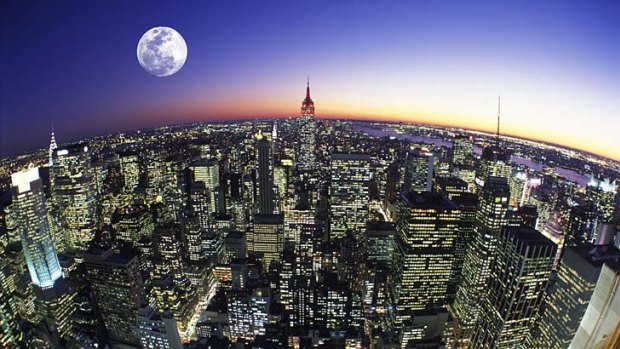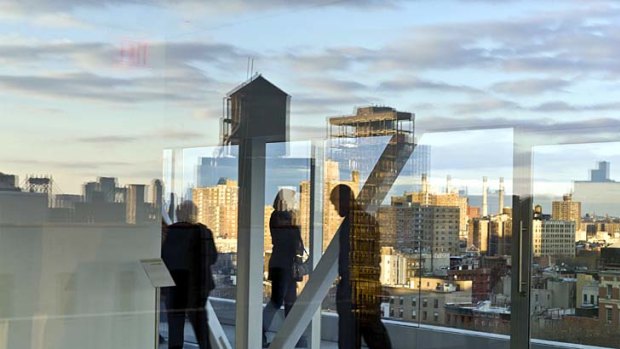
New heights ... the view from the Top of the Rock deck at the Rockefeller Centre.Credit: Getty Images
From street level to bird's-eye view, Stephen Phelan takes a personal walking tour of the morphing skyline of New York.
The walls are made of glass and the bed of "memory foam". Lying flat on my back with the curtains wide open and the mattress moulding itself around me, I can see the lights of downtown Manhattan at my left foot. If I turn to look along my right arm, there are the classic skyscrapers of Midtown: Rockefeller Centre, the Chrysler Building, the Empire State. A suite at the Hotel on Rivington is like a bubble floating over New York, loosely tethered to the Lower East Side.
It's too comfortable to stay fully awake in; the view too spectacular for deep sleep. Before dawn I get up and go to the window, order strawberry waffles from room service and sit on the floor in the corner, watching the first morning rays turn the buildings into sundials.
The hotel is 21 storeys, short for Manhattan but tall for this neighbourhood. A semi-transparent modern high-rise amid 19th-century low-rise tenements, it casts a long shadow across the surrounding brickwork, wooden water towers, steaming aircon units and the "hanging gardens of fire escapes", as Richard Price described them in his novel Lush Life. Price was not the first New Yorker to suggest that development in this city often comes at the expense of character.
The hotel looks out of place now but it probably won't in 10 years, as developers continue to move in and the rents climb with the skyline. Many tourists and weekenders can have it both ways, enjoying new galleries, bars and restaurants (including the hotel's own hot-spot dining room, Co-Op Food & Drink) alongside enduring institutions such as Katz's Deli or Yonah Shimmel's Knish Bakery, just around the corner on East Houston Street.
A resident is more likely to point out the irony that this safer, cleaner, pricier Lower East Side was added recently to a list of America's most endangered places by the National Trust for Historic Preservation. From where I'm sitting, it still looks like New York - but where I'm sitting was thin air before the hotel went up in 2005. The nearby New Museum is even more recent, having moved into a custom-built architectural marvel on the Bowery in 2007, each floor a separate square or rectangular block arranged into a child-like stack.

The roof terrace of the New Museum.Credit: AFP
On my visit, the first four levels are occupied with installations by German artist Carsten Holler — all mind-tricks and sensory experiments, weird science in bright colours. But the highlight is the Sky Room on the top floor, an empty event space that provides another wraparound view of the cityscape.
"The Manhattan skyline is like looking at a great work of art," activist and historian Maurice A. Hargraves wrote in his 2006 memoir and polemic, A More Perfect Union. "In the presence of a great work, it is hard to give your attention to anything else." Walk around at street level and you can see that work in progress, changing with your perspective.
The walking is easier than it used to be, on the eyes if not the feet, and this is evidence of change in itself. The director of the New York planning commission, Amanda Burden, has said she wants this to be "a walkable city".
Her department is credited with proactive rezoning policies that are making the concrete island greener and more pleasant. Where there was urban blight, there are now wind turbines and solar panels, bike and bus lanes, a freshly repaired and pedestrian-friendly waterfront, modelled on the Sydney quays. Though still under development, the new East River Esplanade allows for a breezy stroll south to the Battery, where the Staten Island Ferry offers free rides across the harbour and back.
"They should run another boat just for the tourists," the man beside me says as we crowd aboard, the non-natives clogging the outer decks with backpacks and cameras. "Damn right," I tell him, pleased to be mistaken for a fellow commuter, then joining the hordes at the railing to take pictures of Lower Manhattan. There is nothing original in the joy you might take from this round trip - you share it with the millions who made it before you. "Just as you feel when you look on the river and sky, so I felt," poet Walt Whitman wrote in 1856, addressing the New York ferry passengers of the distant future.
But the sights are not the same as they were 150 years ago, or at the turn of the millennium, or even yesterday. The negative space left by the twin towers is being steadily filled by the new One World Trade Centre, formerly known as the Freedom Tower. When completed, it will be the tallest structure in the city, replacing those lost holders of that title, while reclaiming it from the grand old Empire State Building (which has dominated Midtown since 1931) and surpassing 21st-century challengers such as the Bank of America Tower (erected in 2009) and the relocated New York Times building (2007).
These giants are in effect invisible from the bottom end of the island but they begin to appear in the distance as I cross to the west side and walk north along the High Line. Perhaps the most public-spirited reuse of city property since the disaster of September 11, 2001, this elevated park cuts a horizontal section through the former dead zones of Hell's Kitchen and the Hudson Yards, following the overhead railway that once carried animals to and from slaughter in the Meatpacking District. The warehouses and factories have become nightclubs and upscale loft apartments, and the track is being supplanted with footpaths, artworks, grass and flowers.
It's difficult to see the downside of gentrification when you're resting on a wooden lounger in the dazzling winter sun, drinking Mexican hot chocolate from a vendor named La NewYorkina. This second phase of the High Line, between West 20th and 30th streets, opened last summer. A third and final phase, scheduled to open next year, will take it all the way to West 34th, where Manhattan turns sharply vertical again.
Confronted by the sheer faces of those skyscrapers, it's always tempting to climb them - the Empire State and Rockefeller Centre still command views from the top of the man-made world that are probably worth the queues and cost. A bigger disadvantage is that the buildings can't be seen from their own observation decks, so each one is missing a major piece of the skyline.
There are lower, less exalted rooftops that make you feel more a part of it. For a fuller sense of immersion, take the rickety lift to the Space Billiard bar and pool hall on West 32nd street. Ideal after hours, the mood inside is low-key and old-school, the beer is unusually cheap and the back stairs lead up and out into the lights like a ladder to the stars.
The fact remains that New York is too big and there's too much to take in at once. Midtown is best appreciated from across the Hudson, in Hoboken, New Jersey (over steaks at a window table in the 3Forty Grill, if you can afford it). And Lower Manhattan looks most beautiful from the far side of the Brooklyn Bridge. The bridge itself completes the picture and a new perspective has recently been added underneath. In the shadows that were once fit only for trolls and muggers, there is now a playground and promenade that is safe to walk at night, though quieter and more deserted as it gets late. The old rotting docks have been transformed into water gardens and parkland, with two piers completed and another four under way. Since September 2011, Jane's Carousel has been in place beside the Empire Fulton Ferry - a restored 1920s merry-go-round encased inside a gleaming glass pavilion by French architect Jean Nouvel.
It's a gorgeous sight, set against the greatest man-made backdrop on Earth. The office towers of Wall Street glow on the water, each one a monument to pride and greed and occupied every day by some of the most hated people of the modern age. But the bankers can't stop you projecting your own hopes on that skyline, or charge you for extracting your own pleasures from it. Taken together, those buildings still make you glad to be human.
Stephen Phelan stayed courtesy of Hotel on Rivington.
FAST FACTS
Getting there
Qantas has a fare to New York from Sydney and Melbourne for about $1480 low-season return, including tax. Fly to Los Angeles (about 14hr), then to New York (5hr 15min); see qantas.com.au. Australians must apply for travel authorisation before departure at //esta.cbp.dhs.gov.
Staying there
Hotel on Rivington has double rooms from $US220 ($206). The hotel's fashionable Co-Op restaurant and Thor bar are open late. See hotelonrivington.com.
While there
The New Museum, 235 Bowery, has outstanding modern art exhibitions and a permanent archive from the artistic life of the Lower East Side. The museum is open 11am-6pm Friday, Saturday, Sunday and Wednesday; 11am-9pm Thursday; closed Monday and Tuesday. The Sky Room is open only at weekends. Entry costs $US14, free 7-9pm on Thursday; see newmuseum.org.
The East River Esplanade is open daily, 6am-midnight; see nyharborparks.org/visit/eari.html.
The High Line is open daily, 7am-7pm; see thehighline.org.
Space Billiard Cafe is open 24 hours, on the 12th floor at 34 West 32nd Street.
Piers one and six of Brooklyn Bridge Park are now open to the public, with renovations being done on the piers in between. There are regular events, activities and food stalls at weekends. See brooklynbridgepark.org
Sign up for the Traveller Deals newsletter
Get exclusive travel deals delivered straight to your inbox. Sign up now.